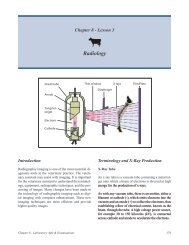Chapter 14 - Lesson 1 Surgical Instruments & Terminology
Chapter 14 - Lesson 1 Surgical Instruments & Terminology
Chapter 14 - Lesson 1 Surgical Instruments & Terminology
You also want an ePaper? Increase the reach of your titles
YUMPU automatically turns print PDFs into web optimized ePapers that Google loves.
Needle holders are locking forceps that are used to<br />
hold a suture needle when installing stitches or closing<br />
a surgical incision.<br />
Scalpels<br />
A surgical cut made into a tissue or organ is called an<br />
incision. <strong>Surgical</strong> scalpels are used to make incisions<br />
and for excision of tissues or organs.<br />
A surgical scalpel is a very sharp knife. Often the handle<br />
and the blade are packaged separately and assembled<br />
by the surgeon at the beginning of the operation;<br />
this maintains the sterile field. In some cases, the surgical<br />
scalpel is a single unit. Replaceable blades and<br />
handles come in different sizes and styles so the surgeon<br />
can perform operations on all types of animals.<br />
A dissecting scalpel or tenotome is for fine dissection<br />
and cutting or dividing tendons.<br />
Tubes<br />
Veterinarians commonly use lengths of tubing during<br />
operations and as part of wound healing. A tube that<br />
is inserted into a body cavity for drainage of fluid is<br />
called a drain.<br />
A cannula is a drain that is used to release build-ups<br />
of fluid or gas from animals. A trocar is a sharp stylet<br />
(or needle) enclosed in the cannula that is inserted<br />
through the wall of the body cavity. When the stylet<br />
(trochar) is withdrawn, the fluid or gas can drain<br />
through the cannula.<br />
Catheters are tubes made of either metal or rubber that<br />
are inserted into body structures, permitting the passage<br />
of fluids into or out of the body through anatomic<br />
orifices or incisions during and after an operation.<br />
Body structures that are commonly catheterized are<br />
the urinary bladder and blood vessels.<br />
References<br />
Hurov, L. (1978). Handbook of veterinary surgical<br />
instruments and glossary of surgical terms.<br />
Philadelphia, PA: Saunders.<br />
Miller, C. W. (2003). Bandages and drains. In: Textbook<br />
of small animal surgery (pp. 244-249).<br />
Philadelphia, PA: Saunders.<br />
304<br />
Questions<br />
1. Describe the function of the following surgical<br />
instruments:<br />
a. Thumb forceps<br />
b. Hemostats<br />
c. Operating scissors<br />
d. Ecraseur<br />
e. Scalpel<br />
Activity<br />
Bandage scissors, thumb forceps,<br />
hemostats, and scalpel.<br />
1. Under the supervision of a veterinarian, handle<br />
various surgical instruments in the different surgical<br />
packs. Observe the actions and purposes of<br />
each instrument.<br />
<strong>Chapter</strong> <strong>14</strong> - Assisting With Surgery




